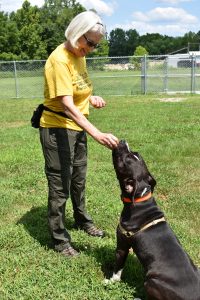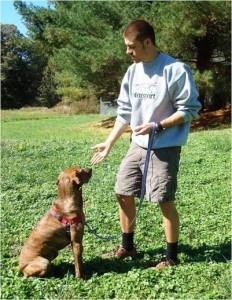Training your dog can be a rewarding but challenging endeavor, especially when there are so many different methods being promoted. No matter what type of training you use, here are a few strategies to help you be successful in your training process:
 Be consistent. Dogs learn best when the commands that they receive are consistent. Even small changes can be difficult for them to process. Make sure that you use the same words, gestures, and body language each time you give a command. If you have multiple people in your household, make sure that everyone is on board and using the same commands. Also make sure that everyone agrees on the rules for the dog, such as whether the dog is allowed on the couch or the bed.
Be consistent. Dogs learn best when the commands that they receive are consistent. Even small changes can be difficult for them to process. Make sure that you use the same words, gestures, and body language each time you give a command. If you have multiple people in your household, make sure that everyone is on board and using the same commands. Also make sure that everyone agrees on the rules for the dog, such as whether the dog is allowed on the couch or the bed.
Reward positive behavior. When dogs obey commands but are not rewarded, they don’t realize that they did the right thing. If your dog listens to a command, make sure that you reward them with praise, pets, and treats. Dogs also aren’t capable of reflecting on their behavior, so make sure that you give the reward immediately after they’ve done the behavior that you want, so they know exactly what they are being rewarded for.
Ignore bad behavior. Most behaviors that you don’t want your dog to engage in can be extinguished by ignoring them. For example, if your dog jumps on you when you get home, turn your back and ignore him until he stops jumping, and then reward him with praise and treats when he has stopped jumping.
Have realistic expectations. It takes dogs time to learn new behavior, so be patient. Making changes might take longer than you expected. Just as it takes people time to learn a new language, it takes time for dogs to learn the language and commands that you are teaching them.
Be intentional about training sessions. Keep training sessions short, about 10-20 minutes, and have them 3-4 times per day. It can also be helpful to plan training sessions for when your dog is hungry, given that they will be more motivated to receive treats.
 Listen to your dog. Forcing dogs to do things that they aren’t comfortable with will just make them more anxious and less likely to listen to you in the future. Pay attention to their body language and whether they are comfortable in a given situation. If your dog is uncomfortable with something, such as going into a crate that they don’t like, then go slowly and reward any progress that they make.
Listen to your dog. Forcing dogs to do things that they aren’t comfortable with will just make them more anxious and less likely to listen to you in the future. Pay attention to their body language and whether they are comfortable in a given situation. If your dog is uncomfortable with something, such as going into a crate that they don’t like, then go slowly and reward any progress that they make.
Contact a trainer. When you’ve tried everything that you know and you’re struggling with training your dog, contact a reputable trainer in your area to seek additional help. They can help you to assess the situation and identify obstacles that might be contributing to your difficulties.
Training is a great opportunity for you and your dog to bond and have some fun together. Try not to put too much pressure on your dog, or on yourself, to “get it” right away.
